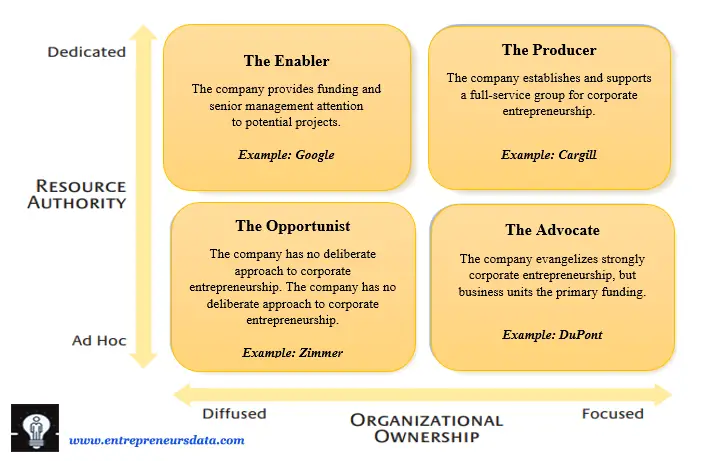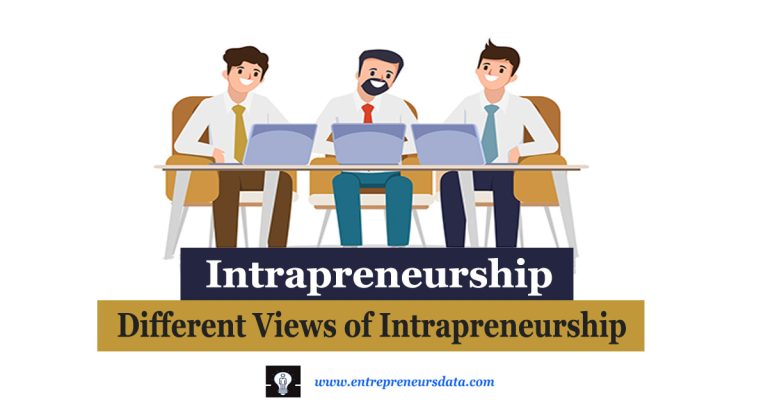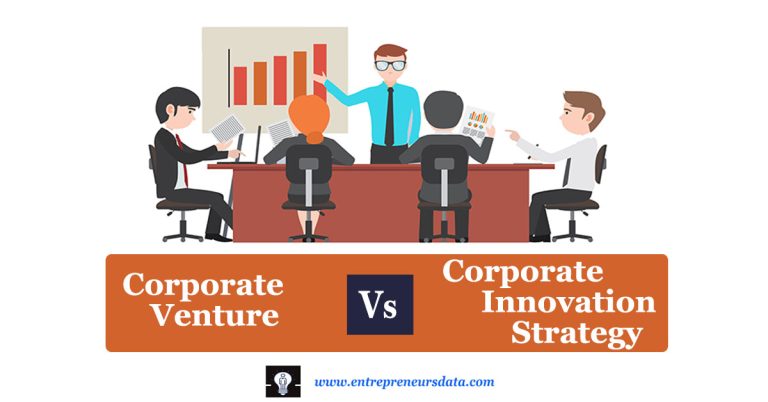Corporate Entrepreneurship: Definition, Types, Examples & how it works – Corporate entrepreneurship is the procedure by which teams within an established company conceive, foster, launch and manage a new business separate from the parent company but leverages the parent’s properties, market position, competencies, or other resources.
What is Corporate Entrepreneurship?
First, though, what exactly is corporate entrepreneurship? We define the term as the procedure by which teams within an established company conceive, foster, launch and manage a new business separate from the parent company but leverage the parent’s properties, market position, competencies, or other resources.
It varies from corporate venture capital, which usually pursues financial investments in external companies. Corporate entrepreneurship is above just new product development. It can include innovations in services, channels, brands, and so on. Corporate entrepreneurship initiatives seek to overcome such limitations. In the past, companies have strained to implement corporate entrepreneurship by rivaling an innovation leader.
Learn more about Innovation – Click here
Definitions of Corporate Entrepreneurship
- Corporate entrepreneurship is the process of creating new businesses within established organizations. – Steven Kuratko (1993)
- Corporate entrepreneurship is the pursuit of opportunities, the discovery and exploitation of new ideas, and the creation of new products, services, or markets by established organizations. – Michael T. Hannan and John Freeman (1989)
- Corporate entrepreneurship is the process of creating new value through innovative organizational activities. – James B. Quinn (1985)
- Corporate entrepreneurship is the process of creating new businesses within established organizations by individuals who are willing to take risks and innovate. – Howard H. Stevenson and David E. Gumpert (1985)
- Corporate entrepreneurship is the process of creating new businesses within established organizations by identifying and exploiting opportunities that are not currently being served by the firm. – Robert D. Hisrich and Michele P. Peters (1985)
- The process of generating new value through creative organizational initiatives that are in line with the company’s strategic objectives is known as corporate entrepreneurship. – John Freeman and Michael T. Hannan (2016)
- Corporate entrepreneurship is the process of launching new enterprises inside well-established corporations and is characterized by a high level of creativity, risk-taking, and entrepreneurial leadership. 2020 James B. Quinn
- Corporate entrepreneurship is the process of starting new companies inside of current enterprises that can respond to shifting market conditions and produce long-term growth. – David E. Gumpert and Howard H. Stevenson, 2017
- Corporate entrepreneurship is the process of creating new businesses within established organizations that can disrupt existing markets and create new industries. – Robert D. Hisrich and Michele P. Peters, (2022)
- Corporate entrepreneurship is the process of creating new businesses within established organizations that can use technology to solve real-world problems and create a positive impact on society. – Steven Kuratko (2021)
Four Models of Corporate Entrepreneurship
Two measurements under the direct control of management reliably differentiate how companies approach corporate entrepreneurship.
The first dimension is organizational ownership. Who, if someone, within the organization, has primary ownership for the formation of new businesses?
The second is resource authority: Is there a committed pot of money allocated to corporate entrepreneurship, or are new business concepts funded in an ad hoc manner through divisional or corporate funds or slush funds?
Each model signifies a distinct way of fostering corporate entrepreneurship. A closer look at the models exemplifies how they help companies build corporate entrepreneurship in dissimilar ways. Together the two dimensions produce a matrix with four dominant models: opportunist, enabler, advocate, and producer.
Let’s discuss every model one by one.
01. The Opportunist Model in Corporate Entrepreneurship
All companies start as opportunists. Without any chosen organizational ownership or resources, corporate entrepreneurship proceeds based on the determinations and serendipity of intrepid project champions persons who toil against the odds, creating new businesses often in spite of the business.
Zimmer has R&D organizations that assume new product development but no proper organization or devoted resources for corporate entrepreneurship. The two then got permission from top management, who approved the use of company resources for idea development and experimentation.
The new medical approach mandatory innovations in training. So the company recognized the Zimmer Institution, and by 2006 more than 6,000 doctors were being trained. There are a dozen dissimilar types of minimally invasive surgical procedures. The resulting improvement in patient outcomes has led to some private insurers paying a premium for certain Zimmer procedures.
The opportunist model works fine only in trusting corporate cultures that are open to testing and have varied social networks overdue the official hierarchy.
Consequently, the opportunist approach is unreliable for many firms. As a result of its past achievement with slightly invasive surgical procedures; Zimmer has founded more formal development practices for carrying new businesses to market. As such, the company has begun to progress beyond the opportunist model.
Read – Technopreneurship
02. The Enabler Model in Corporate Entrepreneurship
The basic premise of the enabler model is that workforces across a business will be willing to develop new concepts if they are assumed adequate support.
In the greatest evolved styles of the enabler model, companies provide the following: clear standards for selecting which opportunities to follow, application rules for funding, decision-making clearness, both recruitment and retention of entrepreneurially minded employees, and, possibly above all, active support from senior administration.
Google Inc. is the print child of the enabler model. Keval Desai, a Google program manager, describes his company in the following way. We’re really an internal ecosystem of entrepreneurs… sort of like the Valley ecosystem but inside one company. At Google, employees are allowed to spend 20% of their time. For promoting their ideas to colleagues, assembling teams, exploring concepts, and building prototypes.
If the team trusts it has a victor, it appeals to the Google Product Board for funding. Effective project teams receive support from the Google Product Strategy Forum to express their business models and set milestones. Importantly, Google applies no predetermined criteria or hurdle amounts to the projects. As long as a project seems to have potential and continues the interest of Google employees, it can remain.
At any given period, Google typically supports more than 100 new commercial concepts in different stages of progress. And data about the projects is continued in a central, searchable database. Managers estimate that approximately 70% of the projects support the company’s core business. In some fashion, 20% represent emerging business ideas and 10% pursue speculative experiments.
Google’s business culture, dynamic market, and strange access to capital make the company challenging to imitate. Nonetheless, other organizations have had victory using the enabler model. Well-designed enabler performances also have the side advantage of sensational senior management. To determine, innovative fresh employees, allowing the firm to identify and cultivate upcoming leaders.
But firms should be conscious that the enabler model is not fair regarding transmission capital for corporate entrepreneurship. Google spends a strange volume of time and effort on recruiting. Without necessary support from high-ranking administration, capable concepts can end up as victims of conflicts with recognized businesses. Another risk is that the enabler model could wick into careening for dollars. In which people apply for capital for ordinary business units. Tasks for ideas that they are not truly interested in following.
Learn more about 10 Types of Innovations – Click here
I Love My Boss PS I Work For Myself Mug
03. The Advocate Model in Corporate Entrepreneurship
What about cases in which finance isn’t really the issue? In the advocate model, a firm assigns organizational proprietorship for the creation of novel businesses while purposefully providing only modest budgets to the core group.
Advocate organizations perform as evangelists and novelty experts, facilitating corporate entrepreneurship in combination with business units. The program offers employees an extensive range of support, everything from idea conceptualization to commercialization.
For example, it includes a four-day business creator session that helps people create and arrange different business conceptions. After this, a team will characteristically occupy from four to eight weeks. Developing a comprehensive business plan, with a 180-day contract with senior administration to address key uncertainties of the future concept. Then the team and an enabler from the Market Driven Growth program will present the plan to business-unit management for approval.
Accomplishment within one business unit has a way of constructing interest from others, and over time teams like those at DuPont can become acute alteration agents. As DuPont’s Cooper reminiscences, I thought I’d spend the utmost of my time facilitating the design and building of new companies…. Instead, I spent at least half my time supporting them.
The core of the Market Driven Growth program is presently operated by five full-time employees.
Although DuPont’s senior administrators actively and openly backed the program, they have never delegated its adoption by the company’s different corporate units. To win that support, the program functioned with leaders from the business entities early on to aid define the mission, growth domain, and standards for opportunities they would be ready to fund.
In 1999, DuPont’s corporate head office invested in the process improvement and the pilot engagements to consent to the program to increase credibility, but after that, each business unit had to pay for its own manner. Today, DuPont still doesn’t require its business units to contribute, but they do so because they spot the worth of the initiative. One of the program’s initial supporters was Ellen Kullman, then group vice leader for DuPont’s safety and protection businesses, who has since become a passionate champ of the initiative.
Entrepreneurship Education: Process, Method, or Both? – Click here
04. The Producer Model in Corporate Entrepreneurship
A few firms such as IBM, Motorola, and Cargill follow corporate entrepreneurship. They launch and support formal organizations with important devoted funds or active effect over business-unit finance. As with the enabler and advocate models, an objective is to inspire latent entrepreneurs. But the creator model also aims to defend emerging projects from turf battles. Inspire cross-unit collaboration, build possibly troublesome businesses, and produce paths for administrators to follow careers outside their business units.
To follow corporate entrepreneurship, Cargill Inc., the $75 billion global agriculture products and Services Business. Based in Wayzata, Minnesota, has recognized its Emerging Business Accelerator. As David Patchen, the group’s founder and managing director, recalls, Prior to the EBA. We required a clearly defined process for the following opportunities. That fell outside of the scope of current business units and functions…. We needed a new method to match our business units and Cargill Ventures.
So the new technology was shifted to the Emergent Business Accelerator, which brought the contribution to the market.
Such victories have aided the Emerging Business Accelerator to become a global clearinghouse. For new concepts and worthwhile proposals across Cargill. The group upholds a Web site for people to submit ideas, both from inside and outside the firm. When an opportunity seems promising, the Emerging Business Accelerator grows a high-level plan. Performs due assiduousness, recruits aptitude, and if approved by the group’s board of executives. In the primary stages, the project team focuses on purifying their concept, business model, and market aids.
It chooses, staffs, and monitors but does not function new business opportunities. In spirit, it manages the procedure but not the ideas, which helps build belief and inspires collaboration between stakeholders. Cargill has originated that transmission projects to managers with other profit-and-loss duties do not work, so full-time teams are created.
The producer model is not without its share of contests and risks. First, it can involve important investments over numerous years. Motorola’s corporate entrepreneurship group. For example, has an annual budget in the tens of millions of dollars. Also devoted staff of more than 35 people.
Read about the 4Ps of Innovations – Click here
Selecting the Right Corporate Model
Evolving from the speculator model to any of the more thoughtful forms of corporate entrepreneurship. Characteristically starts with an order for growth and a broad, clearly communicated vision. When a company’s vision for growth is too thin. It will likely end up with just incremental concepts, while a broader vision helps everybody think outside the well-known box. DuPont, for example, used the phrase beyond the molecule to describe it. Desire to go beyond traditional bulk chemicals, adding services and knowledge to its aids.
Next, the vision is set, and a company wants to describe specific objectives. At Google, for instance, a Web application sample might require only a few engineers. In companies with self-managed groups of practice and skilled networks, enabler programs can quicken the commercialization of ideas. That arises from networks of knowledge workers.
For firms that want to quicken the growth of reputable divisions, the supporter model might be the finest option. Because of the limited resources of this model, executives must tailor initiatives to the benefits of existing lines of business. Employees have to cooperate intensively throughout the organization. With respect to resources, the enabler model can usually be maintained in a much leaner manner than moreover the advocate or producer models.
Simple procedures communicated companywide, decided by a senior team, and managed with a limited workforce can suffice. Clearly, the devoted team and capital vital to the producer model makes it a more resource-intensive choice. But even the advocate model tends to require an important commitment. Although advocates function without a large devoted funding pool. They can need substantial investments in the human capital and practices necessary to help bring new opportunities to completion.
Difference between Businessman and Entrepreneur – Click here
Putting the Corporate Models to Work
The primary task is to acquire consensus from senior management concerning purposes and a path forward. New leaders of corporate entrepreneurship initiatives are often shocked by how much time they spend speaking with corporate and business-unit administration. Nevertheless, such communication is vital, not only to build provision for the new initiative. But also to prevent inner stakeholders from concerning corporate entrepreneurship as a gutter or threat to the company’s established actions. Building new businesses often require contributions from people company-wide. Especially during the launch and scaling. So communication remains serious even after a corporate entrepreneurship program has recognized a proven track record.
Advocate models entail individuals with the instincts, access, and ability to navigate the corporate culture and enable change. Leading advocate organizations form an arsenal of enabling methodologies, new business design tools, and networks with external capabilities. The producer model requires significant capital and staffing and a direct line to top administration. This issue of transition and scaling is definitely not new, but it becomes progressively vexing as companies master the obverse end of innovation.
Indeed, as IBM, Google, DuPont, and others have revealed, corporate entrepreneurship does not have to rely exclusively on serendipity and the grassroots energies of a few project champions. As such, the new business formation will often induce a company to incorporate capabilities and knowledge from the outside. In fact, an effective corporate entrepreneurship program can increase a company’s capability to absorb external knowledge and opportunities, the spirit of open innovation. Obviously, this kind of competence can hardly be constructed overnight, and corporate entrepreneurship will always be a sparring process with few guarantees. But playing it safe is hardly the response for those companies looking to raise organically.
Conclusion
We discuss what is corporate entrepreneurship with definitions. Then we discuss four models of corporate entrepreneurship with each and everyone with definitions as well as real-world examples. Finally, we discuss how to put these models to work. So what is your view about corporate entrepreneurship and our article? we are open to putting your comments in below comment section.
FAQs about Corporate Entrepreneurship
What is meant by corporate entrepreneurship?
Corporate entrepreneurship refers to the practice of fostering an entrepreneurial mindset and applying entrepreneurial principles within an established organization. It involves encouraging employees to think creatively, take risks, and pursue innovative ideas to drive growth and create value within the corporate setting.
What are the 4 types of corporate entrepreneurship?
The four types of corporate entrepreneurship are internal corporate venturing, strategic renewal, employee-initiated innovation, and acquisitions/partnerships. Internal corporate venturing focuses on creating new ventures or projects within the existing organization. Strategic renewal involves reinventing the organization by implementing strategic changes. Employee-initiated innovation empowers employees to contribute innovative ideas and improvements. Acquisitions/partnerships involve seeking external opportunities through mergers, acquisitions, or partnerships with other companies.
What is a good example of corporate entrepreneurship?
Google’s “20% Time” policy is a well-known example of corporate entrepreneurship. This policy allowed employees to dedicate 20% of their work time to pursue their innovative projects. This initiative resulted in the development of successful products like Gmail and Google Maps, demonstrating the positive outcomes of fostering an entrepreneurial spirit within a corporate environment.
What are the features of corporate entrepreneurship?
The features of corporate entrepreneurship include risk-taking, innovation and creativity, opportunity recognition, resource allocation, and flexibility and adaptability. Corporate entrepreneurship involves embracing calculated risks, fostering a culture of innovation and creativity, identifying and capitalizing on market opportunities, effectively allocating resources to support entrepreneurial initiatives, and being flexible and adjustable to changes in the business environment.
What are the functions of corporate entrepreneurship?
The functions of corporate entrepreneurship include driving innovation, enhancing competitiveness, expanding market presence, encouraging employee engagement, and stimulating growth and profitability. Corporate entrepreneurship promotes the development and implementation of innovative ideas, helps organizations maintain a competitive edge, explores new markets and customer segments, empowers employees to contribute and be engaged, and drives business growth and profitability.
What are the five factors of corporate entrepreneurship?
The five factors of corporate entrepreneurship are leadership support, organizational culture, resource availability, external environment, and strategic alignment. Leadership support involves having leaders who champion and support entrepreneurial initiatives. Organizational culture plays a role in fostering an environment that encourages risk-taking and values innovation. Resource availability ensures the allocation of adequate resources to support entrepreneurial activities. The external environment includes market conditions and competition that influence corporate entrepreneurship. Strategic alignment ensures that corporate entrepreneurship aligns with the organization’s overall strategy and goals.

















Thank you. Good article…❤️
Thank you for your valuable comment. subscribe our website to learn more about entrepreneurship.
Can I sіmply say what a comfort to discover somеone that genuinely
understands what tһey’re talҝing about online. You definitely understand how to bring an issue to ligһt and maкe it important.
A lot more people ought to check this out and understand this side of
the story. I can’t believe you’гe not more popular sincе you certainly possess the gift.
Thank you for your valuable comment. subscribe our website to learn more about entrepreneurship.
Thank you for your valuable comment. subscribe our website to learn more about entrepreneurship.
Thank you for your valuable comment. subscribe our website to learn more about entrepreneurship.
can i have the full references to those citations
Thank you for sharing superb informations. Your website is so cool. I’m impressed by the details that you’ve on this blog. It reveals how nicely you perceive this subject. Bookmarked this website page, will come back for extra articles. You, my friend, ROCK! I found just the info I already searched all over the place and just could not come across. What a perfect web site.